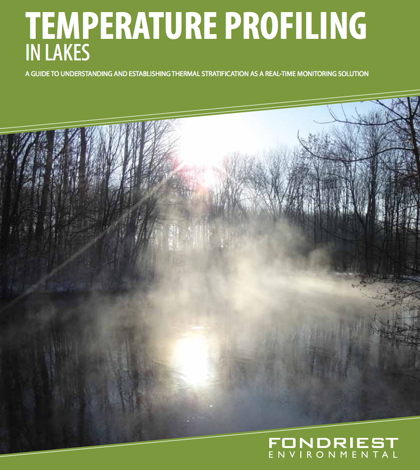New Fondriest Guides: Lake Temperature Profiling, Hydropower DO and Bridge Scour

Fondriest Environmental has assembled new guides to simplify the strategies and equipment required for three more water quality and environmental monitoring applications.
Guides for temperature profiling in lakes, monitoring scour at bridges and monitoring dissolved oxygen at hydropower facilities are available now, joining the earlier release of the guide for monitoring turbidity at dredging sites.
Each guide features typical monitoring systems for each application, guidance on data management and quality assurance, and recommended equipment.
The guides are available in web and PDF versions, complete with graphics, charts and illustrations.
Temperature Profiling in Lakes

Stratification and mixing are among the most important processes in lakes where they occur, with significant impacts on water quality and biology. For lakes that set up in layers in the summer, the hypolimnion can grow hypoxic, cutting off access for fish and potentially leading to complex nutrient cycling issues.
Real-time temperature profiling systems on lakes can help researchers keep track of stratification as it sets up in the springs and breaks down in the fall. The guide describes a typical setup consisting of a thermistor string suspended from a buoy platform.
Web | PDF
Monitoring Scour at Bridges and Offshore Structures

Flowing water can lead to streambed scouring around bridge abutments and piers, compromising the integrity of those structures. The Federal Highway Administration requires states to keep an eye on sites where scour has the potential to weaken highway bridges, and it’s recommended to monitor non-highway sites for scour as well.
A real-time monitoring system can help prevent disasters. The guide describes a setup using a sonar depth sensor that pings the streambed from a fixed installation point, indicating scour as the distance to the bottom of the waterway grows.
Web | PDF
Monitoring Dissolved Oxygen at Hydropower Facilities

Hydropower dams can alter downstream water quality, primarily through affecting dissolved oxygen levels. Under-aerated water drawn from upstream reservoirs is often lower in oxygen than the downstream system, which can threaten life downstream of the oxygen drops too low.
A real-time dissolved oxygen monitoring system downstream from hydropower facilities can help managers stay within federal and state water quality standards. The Fondriest guide shows a typical three-sensor (upstream, impoundment and downstream) system with telemetered data management.
Web | PDF





0 comments